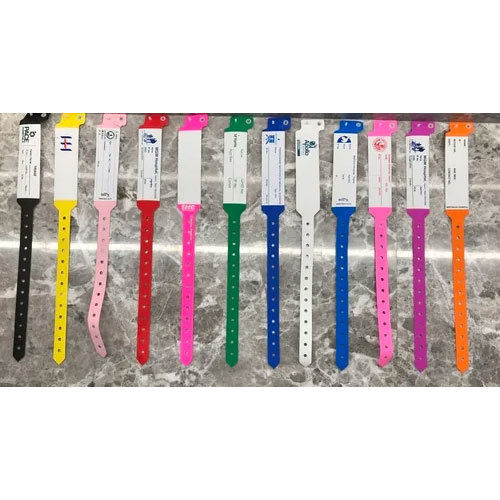A Comprehensive Guide to the Various Types of Patient Identification Band
A Comprehensive Guide to the Various Types of Patient Identification Band
Blog Article
Checking Out the Various Kinds Of Patient Identification Band Made Use Of in Clinical Facilities
In the elaborate world of healthcare, the essential duty of Patient Identification bands usually goes undetected. These bands, varying from straightforward paper wristbands to sophisticated RFID bands, develop the backbone of Patient safety methods, making sure precision in Patient Identification. Yet, the vast variety of these bands, each with its special benefits and constraints, is typically overlooked. As we browse through this topic, one might acquire understanding into the refined complexities and important significance of such bands in medical centers.
Understanding the Value of Patient Identification Bands
While they may look like mere devices, Patient Identification bands play a crucial duty in medical facilities. These bands offer as a crucial tool for validating Patient identity, avoiding clinical errors related to misidentification. The bands commonly display important info such as the Patient's name, age, blood group, and any kind of known allergic reactions. They enable health care specialists to promptly access this crucial info, consequently assisting in timely and exact clinical therapy. Patient Identification bands likewise help in simplifying administrative tasks, guaranteeing precise record-keeping and invoicing. In spite of their simplicity, these bands embody the concept of Patient safety and security, a keystone of top quality wellness treatment. Without them, the threat of clinical mistakes, and subsequently, Patient damage, may substantially boost.
Traditional Paper Wristbands: Their Usage and Limitations
Traditional paper wristbands have actually been a staple in Patient Identification throughout various clinical centers. While their usage is prevalent, they nurture certain constraints that might impact their performance in Patient administration. This section will certainly concentrate on the extent of their application and the intrinsic disadvantages associated with their usage.
Paper Wristbands: Usage Extent
In the world of Patient Identification, paper wristbands have long held a critical function. These bands are generally used in outpatient settings, where the Patient's keep is temporary. The wristbands contain important details such as the Patient's name, date of birth, and an one-of-a-kind Identification number. This basic, yet efficient system, enables doctor to rapidly and properly identify patients, making certain the correct therapy is provided. Paper wristbands are likewise used in emergency situation circumstances, where quick Identification is critical. Their use encompasses occasions like blood donation drives and mass inoculation programs, even more stressing their adaptability. Despite improvements in technology, the modest paper wristband remains a trustworthy and cost-efficient service for Patient Identification in different healthcare scenarios.
Limitations of Paper Wristbands
Regardless of their extensive use, paper wristbands are not without their downsides. Their physical longevity is one of the substantial constraints. Exposure to water, sweat, or rough handling can make them unreadable or perhaps create them to disintegrate. On top of that, paper wristbands typically lack the technological capabilities of more modern options, such as barcoding or RFID chips, limiting their capability to merely showing composed info. The failure to upgrade or customize the information on the wristband is another drawback. If the details is transcribed, clarity can be endangered, leading to potential misidentification. Paper wristbands can cause pain or skin irritability to some people, particularly when put on for prolonged periods.
Barcoded Wristbands: Advancements in Patient Identification
While Patient Identification has actually long been an essential element of healthcare, the arrival of barcoded wristbands signifies a significant leap onward. These bands take advantage of the simplicity of barcoding technology, permitting for Patient information to be rapidly scanned and accessed. They improve the speed and accuracy of Patient Identification, helpful hints reducing the danger of clinical errors connected to misidentification.
Superhigh Frequency Identification (RFID) Bands: a Step Towards Futuristic Healthcare
The evolution of Patient Identification bands has brought regarding the emergence of Superhigh frequency Identification (RFID) Bands (patient identification band). These innovative tools present crucial benefits for healthcare facilities, supplying a much more effective and technically advanced means of Patient Identification. The execution of RFID in medical basics care is a considerable step towards an extra advanced strategy to Patient monitoring and security
Comprehending RFID Bands

RFID Bands: Secret Benefits
Largely, these bands enhance Patient safety and security by supplying precise, immediate Identification, thereby lowering medical errors. RFID bands can store a huge quantity of Patient information, including clinical history and allergies, enabling personalized treatment. Overall, RFID bands represent a considerable advancement in Patient Identification modern technology, profiting both patients and healthcare companies.
Applying RFID in Medical Care
These bands give a smooth way to track and determine individuals, guaranteeing their safety and improving performance in treatment procedures. RFID bands lower clinical mistakes by giving precise Patient Identification, which is important in protecting against misdiagnosis or wrong medicine management. Hence, the implementation of RFID bands is a significant step towards improving Patient security and look at these guys healthcare shipment.

Color-Coded Wristbands: Assisting in Quick and Accurate Medical Diagnosis
In the busy environment of a clinical center, color-coded wristbands have actually emerged as essential devices for swift and accurate Identification of a patient's medical problem. These wristbands, worn by individuals, lug details colors that match to various medical conditions or standings. This system is created to offer immediate aesthetic cues to medical care providers, improving Patient safety and care top quality.
Strategies for Effective Application and Monitoring of Patient ID Bands
Achieving optimum usage of Patient Identification bands necessitates a well-structured approach for their application and management. Patient education is additionally important; people need to understand the objective of the bands and the demand for their continuous wear. It's important to have a back-up plan in area, such as barcode scanning or biometrics, to guarantee that Patient Identification is never endangered.
Conclusion
Patient Identification bands are critical in medical facilities to ensure security and precision. Reliable implementation and management of these bands can considerably minimize clinical mistakes, enhance efficiency, and improve overall Patient care.
These bands, varying from basic paper wristbands to innovative RFID bands, create the foundation of Patient safety and security methods, ensuring precision in Patient Identification.The advancement of Patient Identification bands has actually brought concerning the appearance of Radio Regularity Identification (RFID) Bands. Generally, RFID bands stand for a substantial innovation in Patient Identification innovation, benefiting both clients and health care carriers.
RFID bands lower clinical mistakes by supplying precise Patient Identification, which is critical in preventing misdiagnosis or incorrect medicine administration. Patient education is additionally critical; people need to comprehend the function of the bands and the need for their constant wear.
Report this page